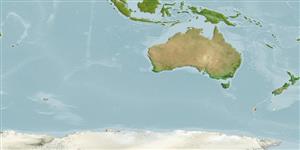Environment: milieu / climate zone / depth range / distribution range
Écologie
marin bathydémersal; non migrateur; profondeur 494 - 714 m (Ref. 47070). Deep-water; 54°S - 55°S
Southern Ocean: Macquarie Island, Kerguelen Plateau.
Taille / Poids / Âge
Maturity: Lm ? range ? - ? cm
Max length : 12.0 cm SL (female)
Found on the continental shelf. Benthic (Ref. 75154).
Life cycle and mating behavior
Maturité | Reproduction | Frai | Œufs | Fécondité | Larves
Nelson, J.S., 1982. Two new South Pacific fishes of the genus Ebinania and contributions to the systematics of Psychrolutidae (Scorpaeniformes). Can. J. Zool. 60(6):1470-1504. (Ref. 47070)
Statut dans la liste rouge de l'IUCN (Ref. 130435: Version 2024-1)
Menace pour l'homme
Harmless
Utilisations par l'homme
Outils
Articles particuliers
Télécharger en XML
Sources Internet
Estimates based on models
Preferred temperature (Ref.
123201): 2.6 - 3, mean 2.8 °C (based on 2 cells).
Phylogenetic diversity index (Ref.
82804): PD
50 = 0.5078 [Uniqueness, from 0.5 = low to 2.0 = high].
Bayesian length-weight: a=0.00389 (0.00180 - 0.00842), b=3.12 (2.94 - 3.30), in cm total length, based on all LWR estimates for this body shape (Ref.
93245).
Niveau trophique (Ref.
69278): 3.3 ±0.3 se; based on size and trophs of closest relatives
Fishing Vulnerability (Ref.
59153): Low vulnerability (10 of 100).
